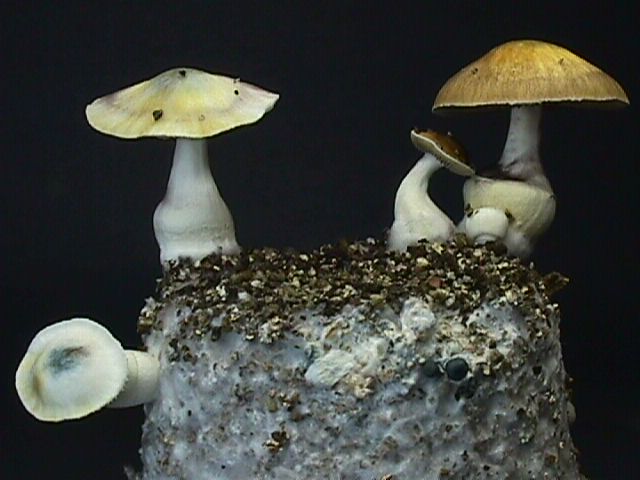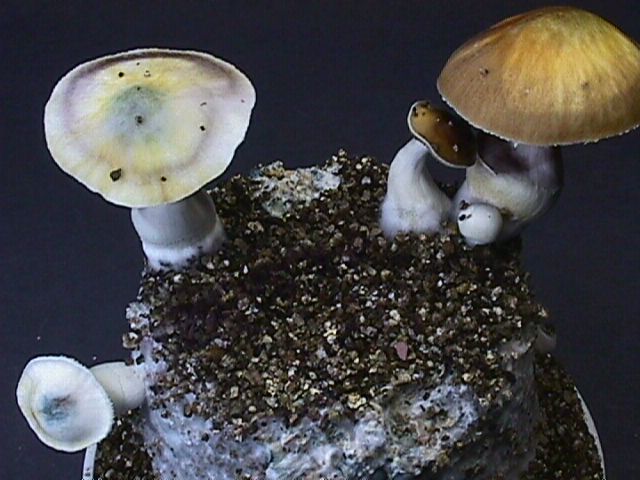

This is a photo of the PF Albino mutant strain. It is a cake that has been picked over. You can see tears where shrooms were picked for spore printing. The remaining shrooms are the stragglers in a first flush. The one on the far left is a pure Albino with a blue discoloration at the top of the cap and some purple spores from another shroom. The shroom in the center is a "half breed" in which some light sporulation is developing but the cap is strange in color - with light colors and greenish and blueish tints. The gills of this "half breed" are mixed up with some light colored gills that are lightly sporulating and white sterile gills. The shrooms on the right are more normal, but at closer inspection, there is something wrong with them also. The colors aren't "right" and they too have a greenish palor to them. The shrooms that were picked for sporulation (evidenced by tears in the cake), have definite GREENISH colors towards the center of the cap and an over all strange lightness in color. The sporulation is not spectacular, but they are giving plenty of purple spores.
This is a very unusual new creature. Very unusual in that it has never existed before. It came into being in the lab of PF. It can be said, that this shroom is truly PF's shroom - a creation of the PF TEK. What has happened, is that through reculturing and isolation of all the "normal" shrooms from the original Albino appearing cakes (pure Albinos at first), the Albinos have returned as a part of the spore race. What is happening is a first in mycology and after a little consultation, let it be known that this is a mystery of genetics and fungi reproduction. The only "explanation" that PF can come up with, is that PF shroom Albinoism is a kind of "refusing to grow up" syndrome. When primordia first appear, they are Albino and get color soon after. Pins (the precursors) of primordia are indeed pure white. So maybe the fact that pure Albinos don't sporulate or develope reproductive systems is related to not "growing up".

This a view from the top of the cake (above). The strange colors are a little easier to see, although the digital photo color rendition isn't perfect. The thing to do if one wants to explore the ultimate in growing the unknown, is to clone that pure Albino or any of them to see what will happen. The results of such an action has already shown to be astounding. And, according to a recent bio-assay, the pure Albinos are excellent potency (the strangest thing yet).
The genetic mutation certainly occurred at the genesis of the spores, because the mutation changed the offspring that followed. The genes were damaged permanently and passed to the progeny. There were many cakes that seemed unaffected, so the two types; the Albino mutant spores and the "normal" spore race lines were separated. But unbeknownst to PF, invisible or unapparant damage did occur to the "normal" specimens.
The damage slowly crept into the spore race lines and by mid summer of 2001, PF had the sinking feeling of empending doom. The Hawaiian and Mazatec spore races were growing on the same PF formulations and in the same terrariums, but were doing great, with the customary excellent fruitings, but the PF which fruits at least equally as well, was doing frighteningly bad with no invitro primordiation, sparse fruitings, strange looking shrooms, off colors and a tendency for sterility (no spores or few forming). And in the worst case, no fruiting at all, even though the mycelium looked healthy. This degradation happened very gradually, over a period of several months. What happened, was that after the albino appearance and the cessation of blacklight use, PF continued to use PF spore race lines emanating from UV (blacklight) exposed specimens. Soon, all the PF spores PF was getting, were descended from the exposed and apparently damaged PF shrooms from the blacklight growing time. Or, the genetically damaged lines spread and gradually became dominant, taking over the PF race lines through spore mixing and spore solution making (PF's lab work).
PF knew exactly what to do - the obvious. PF then contacted a friend and got an old PF spore print from three years ago (not exposed to blacklight fluorescents) plus a fresh print that was propagated elsewhere. They were used with PF jars, and within two months, the proof was there. The "old" spores and the replacement spores were fruiting with total excellence - fast invitro appearing and big healthy (normal) flushes.
There is another recent experiment from TOKYO JAPAN with SHITAKE mushrooms that shows the power of UV (blacklight) light to mutate shrooms and make them sterile (not albino but sterile - no spores produced)).
Here are excerpts from a science paper from Japan describing mutating SHITAKE mushrooms with UV light to get sporeless strains (desirable in large mushroom farms to protect workers from spore allergies). What this means, is that what I did with the blacklight (UV intense) by accident is what these scientists did to SHITAKE on purpose.
S. Murakami - The Tottori Mycological Institute, Tottori, Japan.
Dikaryotic hyphal fragments from a strain (2493) were irradiated with a Toshiba 10-watt germicidal lamp for 30-40 sec at a distance of 10cm. The irradiated fragments were then plated on CY-2 medium containing 20g glucose, 0.5g MgSO4, 7H2O, 0.46g KH2PO4, 1g K2HPO4, 2g polypeptone, 2g yeast extract and 20g agar per litre of water, and incubated at 25oC. The UV treatment and the incubation were performed in darkness. Lethal rate was more than 95%. Viable colonies were then isolated and transferred on to fresh CY-2 medium.
From 11,500 colonies treated with UV irradiation, 24 spore-deficient mutants and 233 strains with reduced sporulation were detected. Imbernon & Labarere (1989) reported that UV treated strains of Pleurotus ostreatus and P. pulmonarius exhibited some abnormality in morphology and yields of fruitbodies. In our experiment, pilei of the spore-deficient mutants were either very thin at the margin or small in size, or their stipes were slender and because bent.
Thus less than 4% of the geminated spores formed colonies. The reduction in compatibility, spore production and viability in the basidiospore progeny stated above, may have an important implications for microevolution in fungi.
PROFESSOR FANATICUS
2004 A.D.